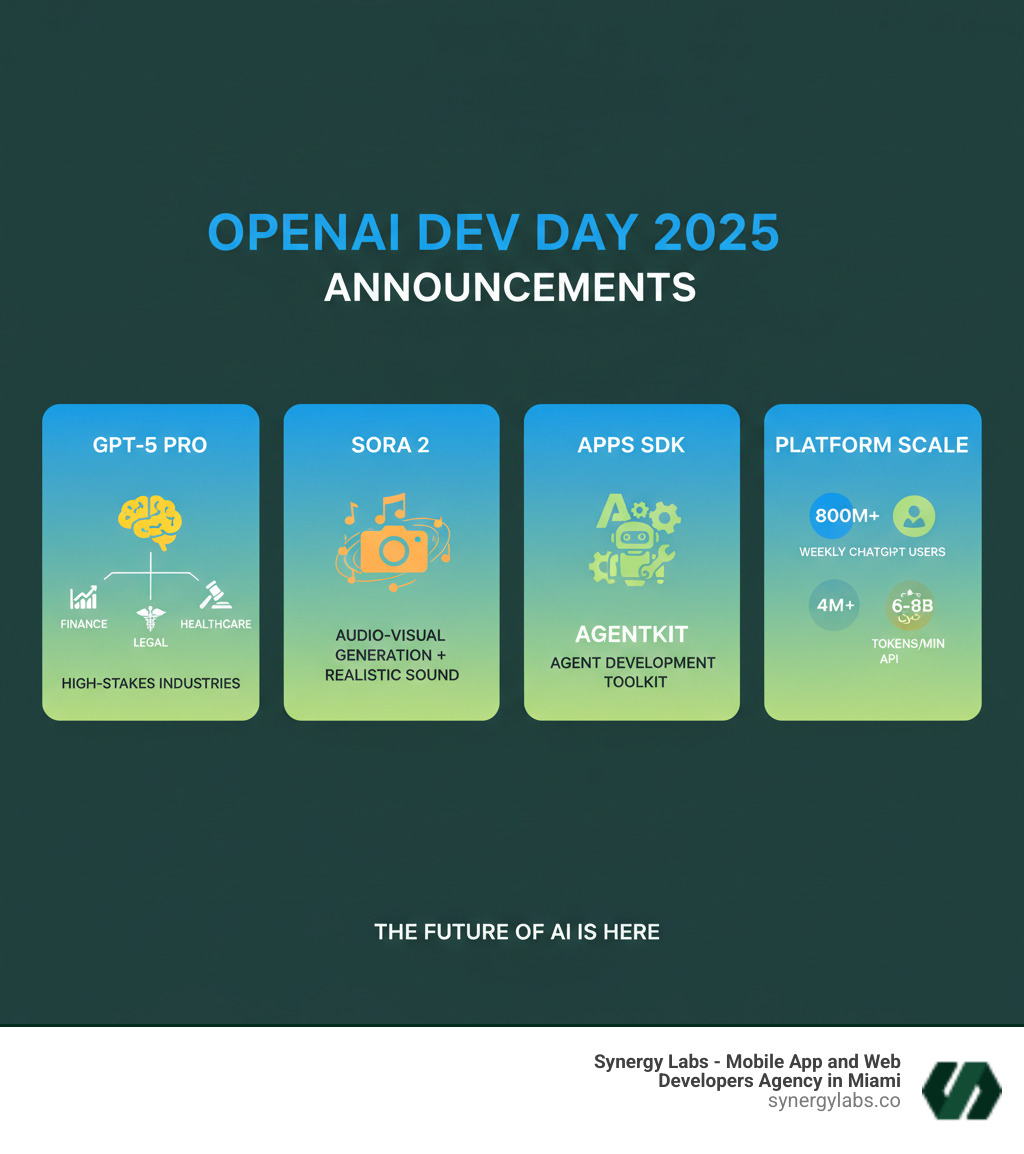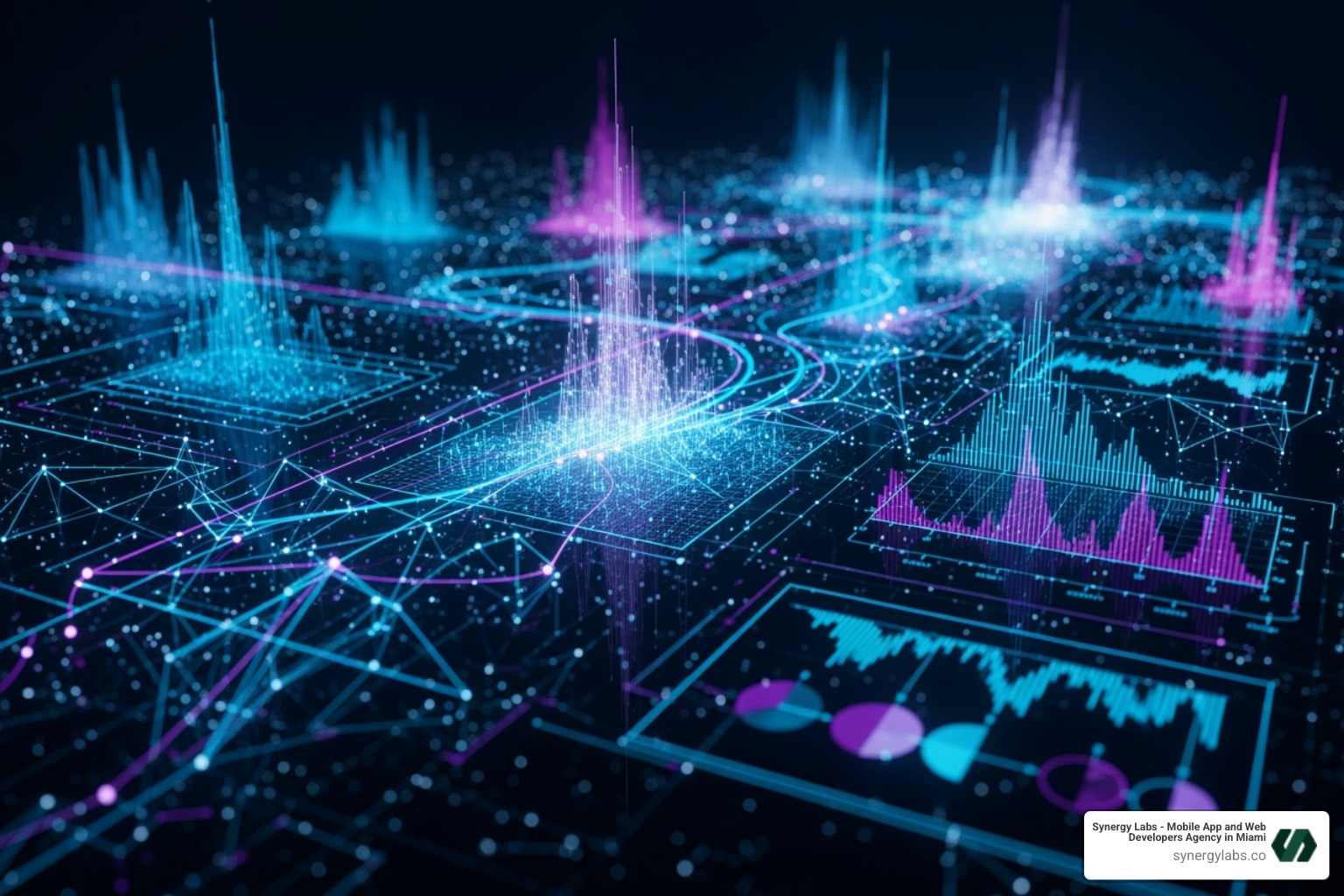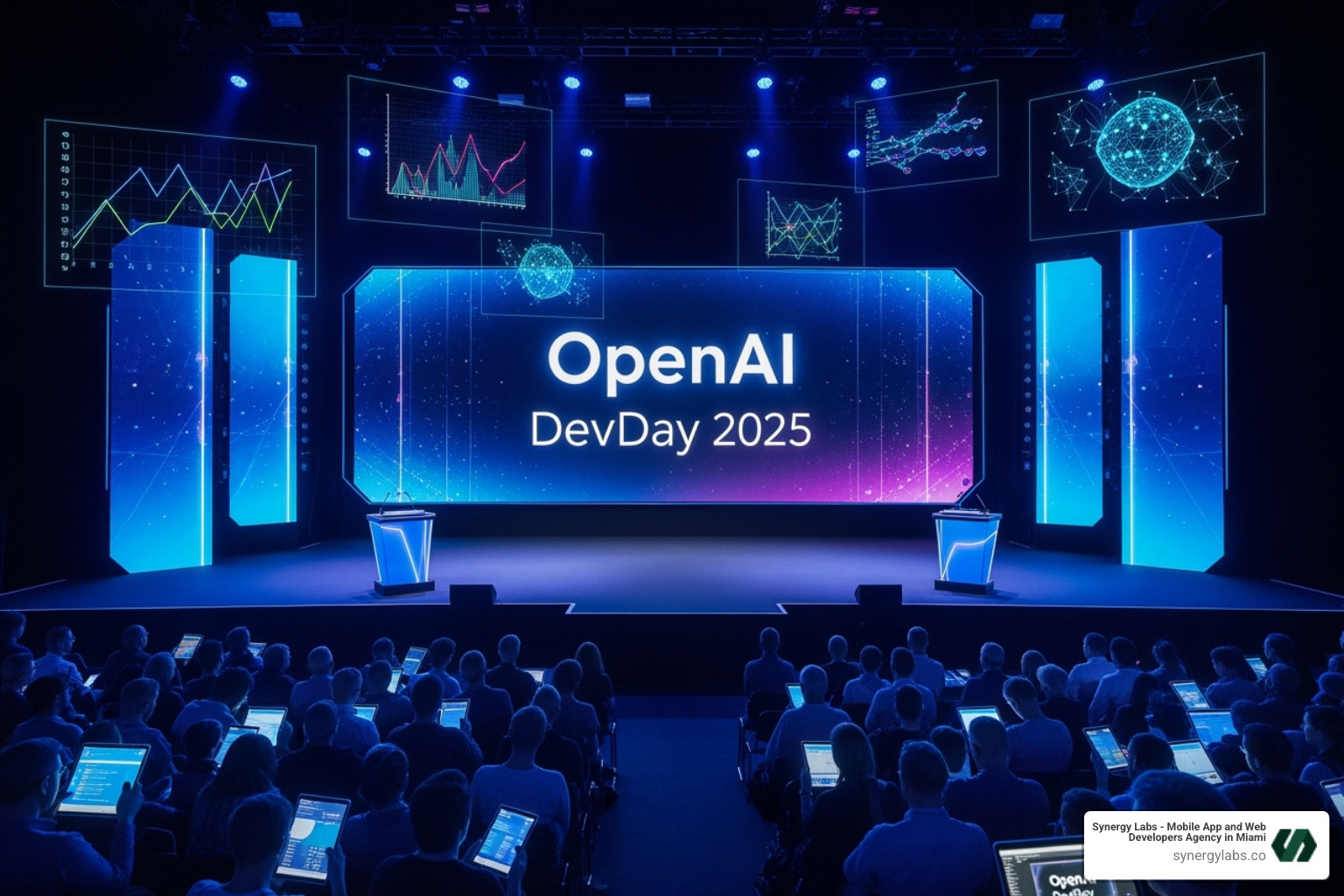Partner with a TOP-TIER Agency
Schedule a meeting via the form here and
we’ll connect you directly with our director of product—no salespeople involved.
Prefer to talk now?
Give us a call at + 1 (645) 444 - 1069
"The October 6 event in San Francisco unveiled a platform change moving OpenAI from research to practical, production-ready tools."

OpenAI DevDay 2025: What You Missed, Major Announcements and Roadmap marks a fundamental shift for developers. The October 6 event in San Francisco unveiled a platform change moving OpenAI from research to practical, production-ready tools.
Key Announcements:
The Numbers:
OpenAI is now a developer platform, enabling third-party apps to reach hundreds of millions of users. The event also teased hardware ambitions with Jony Ive, the $500 billion Stargate datacenter project, and a clear message: expansion and innovation are prioritized over near-term profitability.
As a product strategist and development expert, I've guided founders through AI integration challenges like those presented at DevDay 2025. Having led complex mobile and web projects, I understand how platform shifts create both opportunity and complexity for startups.

OpenAI DevDay 2025: What You Missed, Major Announcements and Roadmap terms you need:
OpenAI DevDay 2025 unveiled two models that fundamentally change what's possible with AI. These aren't just tweaks; they're genuine leaps forward that open entirely new doors for developers and businesses.
OpenAI's announcement of GPT-5 Pro marked a shift. This isn't a general-purpose chatbot; it's a precision instrument for high-stakes situations where mistakes are unacceptable.
GPT-5 Pro is designed for high-accuracy reasoning and deep analysis and is now available via API. The target industries are telling: finance, legal, and healthcare. These are fields where every decision carries weight, and a misinterpreted clause, miscalculated risk, or overlooked medical interaction can have serious consequences. GPT-5 Pro is engineered to handle these scenarios.
For us at Synergy Labs, this opens the door to applications that augment human expertise. Imagine legal tools analyzing thousands of precedents or financial systems processing market data with best accuracy. This is AI-driven growth in practice—giving professionals superhuman capabilities, not replacing them.

For developers, the reliability and precision of GPT-5 Pro make it viable for production environments where accuracy is essential.
While GPT-5 Pro impressed with its analytical power, Sora 2 captured imaginations. Building on the original, Sora 2 adds a crucial element to video generation: sound.
Realistic video generation is just the starting point. Sora 2 creates synchronized audio and rich soundscapes that make generated videos feel truly alive. Imagine generating a video of a busy coffee shop with perfectly synchronized sounds—the hiss of an espresso machine, murmuring conversations, and clinking cups.
The level of creative control is remarkable. Developers can specify camera direction, control visual styles, and expand smartphone footage into cinematic wide shots. Physical consistency has also improved dramatically, meaning objects behave more realistically.
OpenAI is making Sora 2 available through a developer API, which opens up fascinating possibilities. A toy designer could animate a sketch with sound, or a marketing team could generate video concepts from a product description. For those serious about exploring these capabilities, OpenAI published a comprehensive Sora 2 prompting guide.

This technology changes the prototyping process. Instead of spending weeks on mockups, teams can iterate on visual concepts in real-time, shrinking the gap between imagination and execution.
The introduction of gpt-realtime-mini was a quieter but equally significant announcement for practical applications.
Here's what matters: gpt-realtime-mini is a low-latency voice model that's 70% cheaper than OpenAI's previous advanced voice offering, while maintaining the same quality. This cost reduction makes many voice features economically viable for the first time.
The model is built for streaming interactions and real-time applications where every millisecond counts. For customer service bots or voice assistants, lag ruins the user experience. gpt-realtime-mini enables the natural, flowing conversations users expect.
Sam Altman noted that voice is becoming a primary way people interact with AI. At Synergy Labs, we see growing client demand for voice-first experiences, reflecting a natural user preference.
The 70% cost reduction makes voice AI accessible to a much wider range of applications, from startups to large-scale customer service operations. This is the kind of practical innovation that accelerates adoption, as we explore in our guide to AI-driven customer service.
For developers, gpt-realtime-mini removes a major barrier to building voice-first products. The combination of low latency, high quality, and affordability means we can finally build the conversational experiences we've been imagining.
The most powerful message from OpenAI DevDay 2025: What You Missed — Major Announcements & Roadmap was about a fundamental change. OpenAI is no longer just building AI models; they're building an ecosystem where developers can create, launch, and monetize AI-native applications. Think of it as an operating system for the AI age.
The Apps SDK announcement is a game-changer, reimagining ChatGPT. It's no longer just a chatbot but a platform for building complete, interactive applications directly within its interface.
Imagine designing a logo with a design tool or browsing real estate listings with interactive maps, all inside your ChatGPT conversation. This is deep, contextual integration, not a clunky plugin. ChatGPT understands your task and assists throughout the process.

For developers, this opens a new distribution channel to ChatGPT's 800 million weekly users. OpenAI is essentially saying, "Build here, and we'll help you reach hundreds of millions of people." They've even introduced the Agentic Commerce Protocol (ACP), a marketplace for paid apps inside ChatGPT, allowing developers to monetize their creativity at scale.
The Apps SDK is built on the MCP protocol, an open standard that makes this integration possible. For Synergy Labs, this is an exciting frontier. We can build applications that meet users where they are, creating natural and effortless experiences. We're already strategizing how to help our clients leverage this unique opportunity.
Building AI agents was once a complex task requiring specialized knowledge and infrastructure. DevDay 2025 changed that with two powerful tools: AgentKit and ChatKit.
AgentKit is OpenAI's solution to this complexity. It's a complete toolkit for building production-ready AI agents. The Agent Builder is a standout feature, offering a no-code interface to visually design agent behavior. You can prototype a customer inquiry agent, for example, by sketching the workflow and testing it without writing any code.
AgentKit also includes Evals, an evaluation framework to measure agent performance. This "report card" for your AI shows where it excels and where it struggles, which is essential for building trustworthy and reliable agents.
ChatKit solves a different problem: integrating chat interfaces into products. It's a UI component library you can embed anywhere for a ChatGPT-powered experience without building it from scratch. The best part is that it's an embeddable iframe that updates automatically with new OpenAI features like improved voice or vision, requiring no rebuilding on your end.
This is valuable for teams that want to focus on their core product. For our work at Synergy Labs, these tools dramatically accelerate development, allowing us to move from concept to prototype in days instead of months. If you're curious about maximizing these integrations, our guide on how to get more out of custom AI integration dives into practical strategies.
OpenAI DevDay 2025 was more than a developer conference; it was a preview of a major business shift. AI is moving from experiment to infrastructure, and companies that adapt now will gain a significant advantage.
The market reacted immediately, with partner stock prices jumping after integration showcases. This demonstrates the measurable value of being in OpenAI's ecosystem and signals a genuine shift in how technology creates business value.
Business leaders should take three key actions: First, view ChatGPT as a distribution platform. If your product is interactive, explore building an app inside it to reach its massive, engaged audience. Second, plan to integrate AI agents into your team using AgentKit to prototype solutions for time-consuming workflows. Third, experiment with Sora 2 for visual content; marketing teams can generate video concepts in minutes.
Strategically, the next successful products will be conversational, contextual, and AI-integrated. This shift to AI-Native UX requires new thinking in product design. Teams need clear roadmaps for agents, chat-native experiences, and AI content creation, with implementation targets for early 2026.
Investing in AI literacy across your organization is no longer optional. The pace of change is extraordinary. Your operations, content, design, and engineering teams all need to understand these tools. For high-stakes industries, models like GPT-5 Pro offer opportunities for custom integrations that can provide genuine competitive advantages.
The bottom line is that companies that proactively integrate AI into their core strategies will thrive. At Synergy Labs, we're already helping our clients steer this landscape, turning these announcements into practical, market-ready applications.
Beyond immediate product announcements, OpenAI DevDay 2025: What You Missed, Major Announcements & Roadmap offered a glimpse into what's next, from human-centric hardware to massive infrastructure projects. OpenAI is architecting an entire ecosystem that will change how we interact with technology.
The collaboration between Jony Ive and Sam Altman signals a refreshing approach to AI hardware. It prioritizes human emotional wellbeing over feature-cramming, aiming to design technology that genuinely improves lives.
The conversation revealed hardware concepts that favor simplicity and thoughtful integration. One idea, described in reports as a "smart speaker without a display," reflects Jony Ive's minimalist philosophy of technology that serves quietly in the background.

The ambitious goal is to create devices that help people feel happier and less disconnected. In an age of constant digital distraction, this focus on improving emotional wellbeing is refreshing. It points to a future of empathetic, not just smart, AI hardware.
For developers and product designers, this signals a shift. The next wave of AI devices will be about creating natural, intuitive, and genuinely helpful experiences, with the human experience as the primary concern.
Building the future of AI requires massive infrastructure. OpenAI's strategic partnerships, particularly with major chipmakers, show a pragmatic understanding of the need for immense compute capacity.
The Stargate project, a $500 billion datacenter initiative, is the kind of investment needed to train and deploy next-gen AI models. It's about creating a foundation for AI to scale to billions of users, handling exponential growth like the 6-8 billion tokens processed per minute via API.
Sam Altman has been transparent about OpenAI's priorities: expansion and innovation over immediate profitability. This long-term thinking allows the company to invest heavily in research, talent, and infrastructure without being constrained by quarterly earnings reports.
These partnerships and investments directly impact developers. A more robust infrastructure means more reliable APIs, faster response times, and confidence in the platform's evolution. It's part of the broader landscape of Top 10 Tech Trends in 2025, where infrastructure and AI advancement go hand in hand.
For Synergy Labs, these developments create a stable foundation for building innovative AI applications. A reliable, improving platform lets us focus on creating value, not worrying about infrastructure. While AGI is distant, OpenAI is building the highway to get there.
OpenAI DevDay 2025: What You Missed — Major Announcements & Roadmap was packed with new tools and possibilities. We've compiled the most common questions to help you make sense of it all.
AgentKit is a complete toolkit for building production-ready AI agents, solving the challenge of reliably bringing an agent idea to life. It bundles everything you need to go from concept to reality.
It includes the Agent Builder for visual, no-code workflow design, enabling rapid prototyping. It also has ChatKit, an embeddable UI component for a ready-made chat interface that stays updated with new features like voice and vision. What makes AgentKit special is its evaluation framework. The Evals system provides feedback to measure performance and refine behavior, acting as a built-in QA for your agent.
The result is a drastically reduced development timeline, from months to days. You can build sophisticated, reliable AI assistants for complex tasks. For Synergy Labs, this accelerates delivery of custom AI integration solutions.
GPT-5 Pro isn't just an update; it's built for professional applications where accuracy is critical, unlike general-use models. It's designed for industries where "pretty good" isn't good enough.
For professionals like financial analysts, lawyers, or healthcare providers, GPT-5 Pro delivers the exceptional accuracy, deep reasoning, and nuanced understanding these high-stakes fields require. Optimized for complex analysis in regulated fields like finance, law, and healthcare, it offers reliability for critical decision-making. It excels at specific, demanding tasks rather than being a generalist.
This power is accessible via API, allowing developers to integrate GPT-5 Pro's advanced reasoning directly into their applications and bring professional-grade AI capabilities to users.
Yes, and it's one of DevDay's most exciting announcements. The new Apps SDK lets you build full-stack, interactive applications directly inside the ChatGPT interface, moving beyond simple plugins.
Imagine users accessing your design tool, booking system, or dashboard directly within a ChatGPT conversation. They can seamlessly switch between chatting with the AI and using your full-featured app.
The distribution potential is huge, with ChatGPT's 800 million weekly users. The Agentic Commerce Protocol (ACP) also allows you to monetize your apps by charging users directly within the ecosystem.
For developers and businesses, this creates a new category of opportunities, similar to the launch of the first mobile app stores. It transforms ChatGPT into a platform for distributing and selling AI-native applications. At Synergy Labs, we're already exploring how to leverage this for our clients.
OpenAI DevDay 2025 was a declaration that AI has transitioned from experiment to essential business infrastructure. GPT-5 Pro offers unprecedented reasoning for high-stakes industries, Sora 2 open ups new creative dimensions, and tools like the Apps SDK, AgentKit, and ChatKit are changing AI application development.
The practicality of these announcements is striking. OpenAI is making AI development more accessible. The no-code Agent Builder empowers product teams, ChatKit keeps interfaces current, and the Apps SDK provides access to ChatGPT's massive user base.
This moment demands action from businesses. Thriving will depend on decisive integration of these tools into operations and products, not on budget size. Across all industries, AI-native thinking must become a core strategy, not a side project.
OpenAI's hardware ambitions and infrastructure investments like the Stargate project show a long-term strategy focused on expansion over profit. This is reassuring for developers, as it means the platform will only grow stronger.
At Synergy Labs, we help businesses steer complex tech shifts. The right partner can transform an AI initiative from a risk to a success. These announcements align with our philosophy: powerful technology is only valuable when integrated to solve real-world problems.
The time to build with AI is now. The tools, platform, and market are ready. What's needed is the vision and execution to apply these capabilities to your business. We help bridge that gap, turning AI potential into tangible, market-ready applications that deliver results.
If you're wondering how these advancements could transform your business, we'd love to explore the possibilities with you. Our AI Infusion services are designed to help businesses integrate the latest AI into their operations and build new AI-powered products.
The future of AI development is collaborative, accessible, and exciting. We're ready to help you become an active participant.

Getting started is easy! Simply reach out to us by sharing your idea through our contact form. One of our team members will respond within one working day via email or phone to discuss your project in detail. We’re excited to help you turn your vision into reality!
Choosing SynergyLabs means partnering with a top-tier boutique mobile app development agency that prioritizes your needs. Our fully U.S.-based team is dedicated to delivering high-quality, scalable, and cross-platform apps quickly and affordably. We focus on personalized service, ensuring that you work directly with senior talent throughout your project. Our commitment to innovation, client satisfaction, and transparent communication sets us apart from other agencies. With SynergyLabs, you can trust that your vision will be brought to life with expertise and care.
We typically launch apps within 6 to 8 weeks, depending on the complexity and features of your project. Our streamlined development process ensures that you can bring your app to market quickly while still receiving a high-quality product.
Our cross-platform development method allows us to create both web and mobile applications simultaneously. This means your mobile app will be available on both iOS and Android, ensuring a broad reach and a seamless user experience across all devices. Our approach helps you save time and resources while maximizing your app's potential.
At SynergyLabs, we utilize a variety of programming languages and frameworks to best suit your project’s needs. For cross-platform development, we use Flutter or Flutterflow, which allows us to efficiently support web, Android, and iOS with a single codebase—ideal for projects with tight budgets. For native applications, we employ Swift for iOS and Kotlin for Android applications.




For web applications, we combine frontend layout frameworks like Ant Design, or Material Design with React. On the backend, we typically use Laravel or Yii2 for monolithic projects, and Node.js for serverless architectures.






Additionally, we can support various technologies, including Microsoft Azure, Google Cloud, Firebase, Amazon Web Services (AWS), React Native, Docker, NGINX, Apache, and more. This diverse skill set enables us to deliver robust and scalable solutions tailored to your specific requirements.








Security is a top priority for us. We implement industry-standard security measures, including data encryption, secure coding practices, and regular security audits, to protect your app and user data.
Yes, we offer ongoing support, maintenance, and updates for your app. After completing your project, you will receive up to 4 weeks of complimentary maintenance to ensure everything runs smoothly. Following this period, we provide flexible ongoing support options tailored to your needs, so you can focus on growing your business while we handle your app's maintenance and updates.